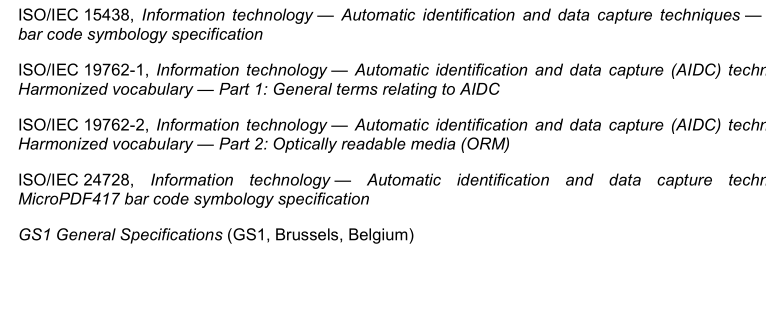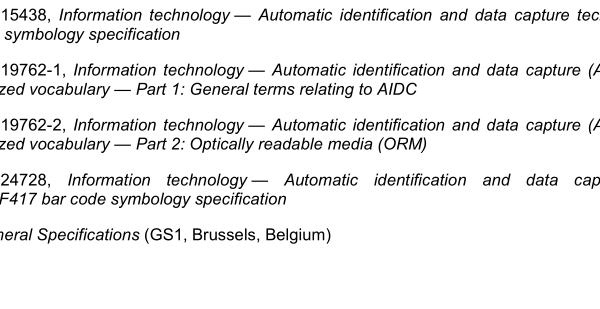ISO IEC 24723:2010 pdf download – Information technology — Automatic identification and data capture techniques — GS1 Composite bar code symbology specification.
In all cases where a CC-A component is shown in the table, the printing software shall automatically use a CC-B component (of the same number of columns) when the data to be encoded exceeds the maximum capacity of the CC-A or other means shall be provided to enable the correct selection of CC-A or CC-B to suit the length of the data. The presence of an add-on symbol shall not affect the choice of 2D component. When the linear component is GS1-128, either CC-A/CC-B or CC-C may be used; see 7.3. 5 Source data encodation into a binary string 5.1 General The user data to be encoded into a 2D component shall always consist of application identifiers and data fields that comply with the data standard of the GS1 General Specifications. The GS1-128 rules for concatenation of AI element strings, such as the termination of a variable-length string by a FNC1 character, shall be followed when encoding a 2D component. Before encoding a 2D component, the given data string is encoded into a binary string, where data characters are represented with a variable number of bits. The resulting binary string consists of two or three binary fields. The fields are: a) Encodation Method (see 5.2), b) compressed data (see 5.3), and c) general-purpose data compaction (see 5.4). The Encodation Method is always encoded as the first field (see 5.2). One or both of the other fields are also encoded in a 2D component. When both are present they are encoded in the order shown above. The compressed data field efficiently encodes data using specific AIs, such as date and lot number or data using AI 90 and serial numbers (see 5.3). The general-purpose compaction field can encode data using any combination of AIs (see 5.4). In the text of this clause, bit fields will be indicated by their binary values enclosed in double quotation marks.
An Encodation Method field of “0” is directly followed by AI data encoded using general-purpose data compaction (see 5.4). The encoded data starts with the first application identifier and its element string data, optionally followed by one or more AI element strings. An Encodation Method field of “10” or “11” is directly followed by a compressed data field, optionally followed by a general-purpose data compaction field (see 5.4). 5.3 Compressed data field If the Encodation Method field is other than a single “0” bit, this indicates the presence of a field of compressed data. The compression is specified to encode the data of specific AI element strings efficiently. An Encodation Method field of “10” (see 5.3.1) is directly followed by a compressed data field suited for marking pharmaceuticals and many other small items requiring an Expiration or Production Date and/or Lot number. An Encodation Method field of “11” (see 5.3.2) is directly followed by a compressed data field suited for many applications for marking small products with alphanumeric data. It may be necessary to sort the AI element strings into the required sequence in order to benefit from the applicable Encodation Method.
ISO IEC 24723:2010 pdf download – Information technology — Automatic identification and data capture techniques — GS1 Composite bar code symbology specification






